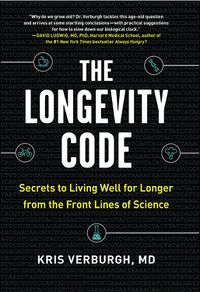The Longevity Code

The Longevity Code is a book written by Belgian medical doctor and researcher Kris Verburgh "on why and how we age — and on the four most crucial areas we have control over, to slow down, and even reverse, the aging process"[1].
Book description[править]
The full title of the book is "The Longevity Code: Secrets to Living Well for Longer, from the Front Lines of Science".
According to Goodreads:
We learn why some animal species age hardly at all while others age and die very quickly, and about the mechanisms at work that slowly but definitely cause our bodies to age, making us susceptible to heart attack, stroke, cancer, pneumonia and/or dementia.
Dr. Verburgh devotes the last third of The Longevity Code to what we can do to slow down the process of aging. He concludes by introducing and assessing the wide range of cutting-edge developments in anti-aging technology, the stuff once only of science fiction: new types of vaccines, and the use of mitochondrial DNA, CRISPR proteins, stem cells, and more.
Table of contents[править]
- Why do we age?
- Making room?
- Dying before growing old
- Young and healthy, old and sick
- Sex and aging
- What causes aging?
- Proteins
- Carbohydrates
- Fats
- Our energy generators and their role in life, death, and aging
- Shoelaces and string
- Other causes, and conclusion
- The longevity staircase
- Avoid deficiencies
- Stimulate hormesis
- Reduce growth stimulation
- Reverse the aging process
- Some thoughts about aging, longevity, and immortality
- Do we really want to grow that old?
- A new society?
- Recipes
- Afterword
Assessment[править]
The following commentary is taken from an online review[2] by David Wood
I found The Longevity Code to address a number of issues in ways that were particularly compelling and engaging:
- Persuasive advice on how to modify diet and lifestyle, now, in order to increase your likelihood to remain healthy long enough to benefit from forthcoming rejuvenation therapies (therapies which Verburgh lists as “Step 4” of a four-stage “longevity staircase”)
- A compelling analysis of different “theories of aging”, in Chapter 1 of his book, including the implications of the notably different lifespans of various animals that seem on first sight to have similar biology
- A down-to-earth matter-of-fact analysis, in Chapter 4 of his book, on the desirability of living longer lives.
One “allowable weakness” of the book is that the author repeats himself on occasion – especially when it comes to making recommendations on diet and food supplements. I say this is “allowable” because his messages deserve repetition, in a world where there is an abundance of apparent expert dietary advice that is, alas, confusing, contradictory, and often compromised (due to the influence of vested interests – as Verburgh documents).